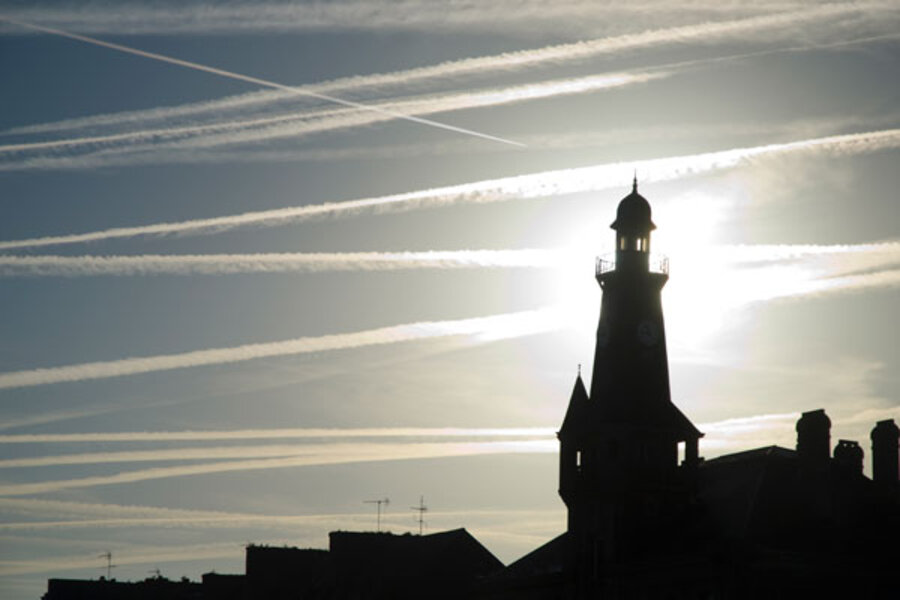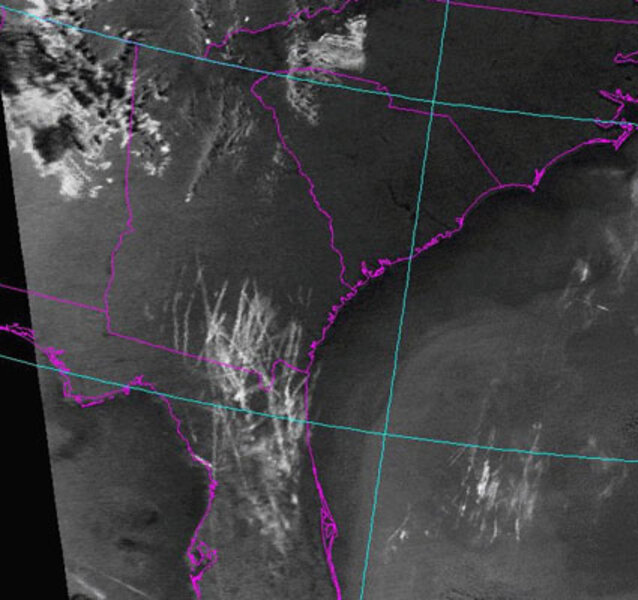Airplane contrails and their effect on temperatures
Maybe you did some airplane travel over the holidays, and maybe, once your plane reached cruising altitude, you noticed the vapor trails from other jetliners crisscrossing your path. Or possibly one day recently, you simply looked up and noticed many thin, white clouds crisscrossing the sky.
These are contrails, perhaps one of the most directly observable ways human activity can change the weather. They form when, as exhaust spews from jet engines, moisture condenses on particles of soot in the subfreezing air.
They usually appear above 26,000 feet where the air is less than -40 C (also -40 F.) But factors besides altitude also play a role in their formation. Depending on how much moisture is in air, for example, contrails last shorter or longer. Moisture availability also dictates whether they form at all, and how much they grow after formation.
As it turns out, they also impact temperatures at Earth's surface, although by how much and in which direction — up or down — is still being worked out.
Initially, scientists thought that contrails, like the naturally occurring cirrus clouds they resemble and sometimes seed, had an overall warming effect. Although contrails clearly reflected incoming sunlight, they also trapped heat from below that would otherwise escape into space. Scientists therefore thought contrails had a net warming effect.
Then Sept. 11, 2001 presented a unique opportunity to study what the sky looked like without airplanes and contrails. In the wake of the 9-11 terrorist attacks, the FAA prohibited commercial aviation over the United States for three days. That's when David Travis, an atmospheric scientist at the University of Wisconsin, Whitewater, thought to look at how temperatures might differ at temperature stations around the country.
He found that [PDF], for those three days, the average range between highs and lows at more than 4,000 weather stations across the US was 1 degree C wider than normal. In other words, contrails seemed to raise nighttime temperatures and lower daytimes ones.
But the real effect was in daytime highs, which were much higher. That would seem to indicate that, contrary to prevailing thinking, contrails might have a net cooling effect.
Certain areas seemed particularly sensitive to the absence of contrails. Because of unique climatic conditions in the atmosphere in these regions — chiefly, moisture-laden air — the Pacific Northwest and the Midwest are often covered by contrails. But when planes stopped flying right after 9-11, Travis also found that these areas saw the most dramatic increase in daytime highs.
Some have suggested that these results were skewed because unusually clear weather prevailed that week in September 2001. In other words, it was natural variation, not the absence of contrails, that led to the large temperature differential immediately following 9-11.
But there's no doubt that whether the net effect is to cool or warm, contrails can quite dramatically change cloud cover.
Immediately after 9-11, other scientists looked at contrails left by military planes, the only aircraft allowed to fly. They noticed that when planes flew in a cloudless area west of Washington D.C., within just a few hours, contrails that had begun as vapor trails just a few meters in width covered 20,000 square kilometers (7,722 square miles).
A 2006 study published in Nature, meanwhile, provided more details. The authors concluded that when a contrail forms — day or night, for example — determines whether the net effect will be warming or cooling. (Here's Scientific American's write-up [PDF] of the article.
Planes flying between 6 p.m. and 6 a.m. comprised only one-quarter of total flights examined. But they were responsible for 60 to 80 percent of contrails' warming effect ontemperatures. That's because contrails at night trap outgoing heat radiation.
Contrails during the day, meanwhile, offset their heat-trapping effect by reflecting incoming sunlight. Likewise, winter flights, which account for only 22 percent of annual air traffic, were nonetheless responsible for half the warming by contrails.
"[F]light rescheduling could help to minimize the climate impact of aviation," conclude the authors.
Or, as the Scientific American article puts it, "Kiss the red-eye good-bye."
Of course, aviation's real impact on climate probably has nothing to do with contrails. In 2005, NASA's James Hansen published a study to that effect. He found that, even if the number of contrails were quintupled, global mean temperature would increase by just 0.03 degrees C (0.05 degrees F.). Aviation emissions, which are rising dramatically, are the true culprit.
According to this Wired story, aviation is on track to have a 1.5 billion-ton carbon footprint by 2025. The entire 27-nation, 457-million-person European Union emits some 3.1 billion tons of CO2 yearly at this point.
And yet, although the net impact of contrails may pale in comparison to the net impact of carbon emissions, engineers are already thinking up solutions to contrail formation. One has proposed a powerful microwave beam mounted on the jet engine. The idea: Evaporate the condensing water and soot particles before they become contrails.
Scientist Frank Noppel, who's researching this idea, says the job would cost just 0.1 percent of a jet engine's power. Sound crazy to have a microwave pointing back the way you came? Rolls-Royce has reportedly filed a patent on the technology.
Editor's Note: The Monitor's Environment section has a new URL. And there's also a new URL for our Bright Green blog. We hope you'll bookmark these and visit often.






